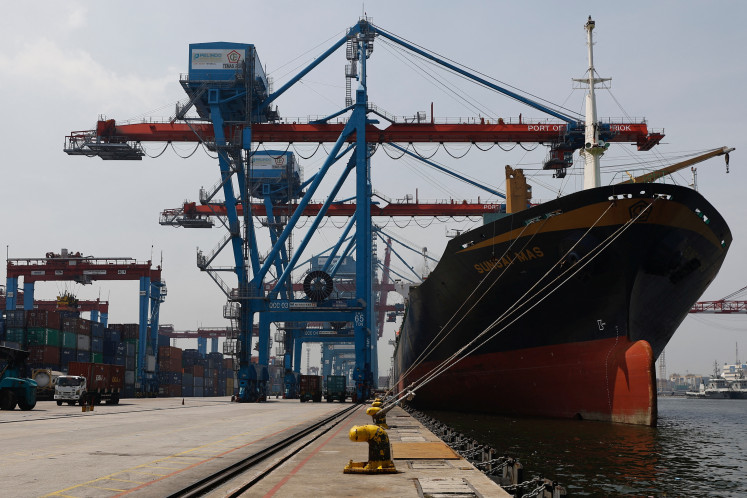Fast-tracking supply chain improvement in Indonesia
There is no doubt that Indonesia has become the darling of the wider Southeast Asian economic region
Change text size
Gift Premium Articles
to Anyone

T
here is no doubt that Indonesia has become the darling of the wider Southeast Asian economic region. With growth forecast at 5 percent this year and one of the largest potential markets in the world, Indonesia has been one of the strongest performing emerging market economies in recent years.
But to continue growing, the country will need to be less dependent on commodity-based industries, and to improve the efficiency and output of its manufacturing, technology and services sectors. To do this, putting in place the right policies and framework to take Indonesia’s supply chain and logistics infrastructure to the next level is essential.
Logistics costs still account for 26 percent of GDP in Indonesia. Based on a 2013 report from Frost and Sullivan, the value of the logistics supply chain industry in Indonesia reached US$25.41 billion in 2012.
But, despite the growing value of the sector, the World Bank ranked Indonesia in only 53rd position in the 2014 Logistics Performance Index (LPI), lower than neighboring countries like Thailand, Vietnam, Singapore and Malaysia.
Limited facilities at the ports and the resulting congestion are a major problem. But the bigger challenge is the total cost of getting products from manufacturers to consumers, and how land transport actually takes up more time than processing in the ports. Inadequate rural roads cause long transport times, roads are often closed, and many poor roads can only be used by small vehicles with high operating costs.
The government has pledged to improve infrastructure by increasing capital spending by $480 billion between 2015-2019 that will be financed by both public and private sectors. These plans will include an additional 15 airports, 24 new ports, and 61 bonded logistics centers. These are also part of the effort to transform Indonesia into an important logistics hub in Asia Pacific.
However, these plans don’t come without challenges. The decentralization of Indonesia means that it is not only the central government that makes the decisions. There are more than 500 autonomous local governments that will need to “buy-in” to any development projects.
Difficulties with land acquisition and long delays in permit issuance, combined with a lack of coordination between different levels of government have impeded infrastructure projects. Then there’s the distance involved in managing supply chains in the world’s largest archipelago.
Populations in cities outside of Java like Medan and Makassar boast increasing purchasing power, but the fact remains that goods and materials need to be shipped from the main ports in Java, Tanjung Priok in Jakarta and Tanjung Perak in Surabaya.
To put it in perspective, the distance from Tanjung Priok to Guangzhou, China, is 2,077 nautical miles, shorter than the distance to Papua, which is 2,737 nautical miles. With long distances putting extra pressures on logistics and supply chain costs, it is actually cheaper to ship from Tanjung Priok to Singapore or Guangzhou than it is to ship to Jayapura in Papua.
The fragmented nature of the forwarding industry also exacerbates the challenges.
Under the existing, and outdated, model of supply chain management, shippers (e.g. large consumer goods companies) work with third-party logistics providers (3PLs) to manage emerging market supply chains on their behalf.
The 3PL manages dozens, sometimes hundreds, of carriers, such as local trucking companies, on behalf of the client, and charges a significant mark-up on the real cost of transport. Carriers have no choice if they want to do business with their largest end-customers, and shippers have little visibility into the actual cost or efficiency of transport.
The government wants to reduce logistics costs to about 19 percent of GDP by 2020. But to compete more effectively with other markets, the question should be whether it possible to achieve more by 2020.
The answer is yes. In fact, the government can bring Indonesia on a par with other OECD countries and reduce logistics costs by 65-70 percent.
The public and private sectors in Indonesia need to effectively partner to improve the supply chain and logistics sector, as a matter of critical urgency. Investing in infrastructure has been a key policy of the incumbent government.
However, to make it work, it needs to support local economies and regions by continuing to build logistics centers across Indonesia, improving road design, and massively increasing investment in road and rail capacity.
This will alleviate the problems of geographically dispersed volumes and port infrastructure limitations. The government should also enforce best practices to improve outdated port operating models, and support platforms which drive backhaul efficiencies to reduce congestion and costs and improve yields for cash-strapped transporters.
From the private sector, it should analyze its own supply and distribution flows. Each variable has the potential to strongly reduce logistics costs, from production, distribution management and cargo collection, to customs clearance, transport to shipping, and delivery.
With the proliferation of technology adoption, a direct data relationship between shippers and carriers can take supply chain management in Indonesia to the next level. Implementing an integrated platform that provides transparency, real time access to supply chain performance and direct access to carriers in emerging markets at transparent rates will drive ongoing supply chain optimization.
But this revolution needs to happen sooner rather than later. As long as infrastructure investment is not enforced correctly and businesses have no visibility into the efficiency of logistics transport providers, it will not only take longer for Indonesia to achieve significant logistics cost reductions. It will also take longer for Indonesia to become a more competitive economy, within the Asia Pacific region and globally.
250 million consumers and the companies working hard to reach them can’t wait — the time is now to build a more effective, transparent logistics market in Indonesia!
_________________________________
The writer is chief executive officer and co-founder of OpenPort, a logistics company. This is a personal view.









